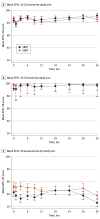Safety and Efficacy of Virtual Prostatectomy With Single-Dose Radiotherapy in Patients With Intermediate-Risk Prostate Cancer: Results From the PROSINT Phase 2 Randomized Clinical Trial
- PMID: 33704378
- PMCID: PMC7953338
- DOI: 10.1001/jamaoncol.2021.0039
Safety and Efficacy of Virtual Prostatectomy With Single-Dose Radiotherapy in Patients With Intermediate-Risk Prostate Cancer: Results From the PROSINT Phase 2 Randomized Clinical Trial
Abstract
Importance: Ultra-high single-dose radiotherapy (SDRT) represents a potential alternative to curative extreme hypofractionated stereotactic body radiotherapy (SBRT) in organ-confined prostate cancer.
Objective: To compare toxic effect profiles, prostate-specific antigen (PSA) responses, and quality-of-life end points of SDRT vs extreme hypofractionated SBRT.
Design, setting, and participants: The PROSINT single-institution phase 2 randomized clinical trial accrued, between September 2015 and January 2017, 30 participants with intermediate-risk prostate cancer to receive SDRT or extreme hypofractionated SBRT. Androgen deprivation therapy was not permitted. Data were analyzed from March to May 2020.
Interventions: Patients were randomized in a 1:1 ratio to receive 5 × 9 Gy SBRT (control arm) or 24 Gy SDRT (test arm).
Main outcomes and measures: The primary end point was toxic effects; the secondary end points were PSA response, PSA relapse-free survival, and patient-reported quality of life measured with the International Prostate Symptom Score (IPSS) and Expanded Prostate Cancer Index Composite (EPIC)-26 questionnaires.
Results: A total of 30 men were randomized; median (interquartile range) age was 66.3 (61.2-69.9) and 73.6 (64.7-75.9) years for the SBRT and SDRT arms, respectively. Time to appearance and duration of acute and late toxic effects were similar in the 2 trial arms. Cumulative late actuarial urinary toxic effects did not differ for grade 1 (hazard ratio [HR], 0.41; 90% CI, 0.13-1.27) and grade 2 or greater (HR, 1.07; 90% CI, 0.21-5.57). Actuarial grade 1 late gastrointestinal (GI) toxic effects were comparable (HR, 0.37; 90% CI, 0.07-1.94) and there were no grade 2 or greater late GI toxic effects. Declines in PSA level to less than 0.5 ng/mL occurred by 36 months in both study arms. No PSA relapses occurred in favorable intermediate-risk disease, while in the unfavorable category, the actuarial 4-year PSA relapse-free survival values were 75.0% vs 64.0% (HR, 0.76; 90% CI, 0.17-3.31) for SBRT vs SDRT, respectively. The EPIC-26 median summary scores for the genitourinary and GI domains dropped transiently at 1 month and returned to pretreatment scores by 3 months in both arms. The IPSS-derived transient late urinary flare symptoms occurred at 9 to 18 months in 20% (90% CI, 3%-37%) of patients receiving SDRT.
Conclusions and relevance: In this randomized clinical trial among patients with intermediate-risk prostate cancer, SDRT was safe and associated with low toxicity, and the tumor control and quality-of-life end points closely match the SBRT arm outcomes. Further studies are encouraged to explore indications for SDRT in the cure of prostate cancer.
Trial registration: ClinicalTrials.gov Identifier: NCT02570919.
Conflict of interest statement
Figures




Comment in
-
Single dose prostate radiotherapy - a step too far?Nat Rev Urol. 2021 Aug;18(8):445-446. doi: 10.1038/s41585-021-00468-y. Nat Rev Urol. 2021. PMID: 33883723 No abstract available.
-
[Virtual prostatectomy using single dose radiotherapy].Strahlenther Onkol. 2021 Oct;197(10):943-945. doi: 10.1007/s00066-021-01824-y. Epub 2021 Jul 23. Strahlenther Onkol. 2021. PMID: 34297155 German. No abstract available.
-
Single-Dose Radiotherapy for Prostate Cancer-Lessons Learned From Single-Fraction High-Dose-Rate Brachytherapy-Reply.JAMA Oncol. 2021 Oct 1;7(10):1573. doi: 10.1001/jamaoncol.2021.2694. JAMA Oncol. 2021. PMID: 34351361 No abstract available.
-
Single-Dose Radiotherapy for Prostate Cancer-Lessons Learned From Single-Fraction High-Dose-Rate Brachytherapy.JAMA Oncol. 2021 Oct 1;7(10):1572. doi: 10.1001/jamaoncol.2021.2691. JAMA Oncol. 2021. PMID: 34351373 No abstract available.
-
Re: Safety and Efficacy of Virtual Prostatectomy with Single-dose Radiotherapy in Patients with Intermediate-risk Prostate Cancer: Results from the PROSINT Phase 2 Randomized Clinical Trial.Eur Urol. 2021 Nov;80(5):674-675. doi: 10.1016/j.eururo.2021.08.020. Epub 2021 Sep 10. Eur Urol. 2021. PMID: 34518023 No abstract available.
References
-
- Jackson WC, Silva J, Hartman HE, et al. . Stereotactic body radiation therapy for localized prostate cancer: a systematic review and meta-analysis of over 6,000 patients treated on prospective studies. Int J Radiat Oncol Biol Phys. 2019;104(4):778-789. doi:10.1016/j.ijrobp.2019.03.051 - DOI - PMC - PubMed
Publication types
MeSH terms
Substances
Associated data
Grants and funding
LinkOut - more resources
Full Text Sources
Other Literature Sources
Medical
Research Materials
Miscellaneous

